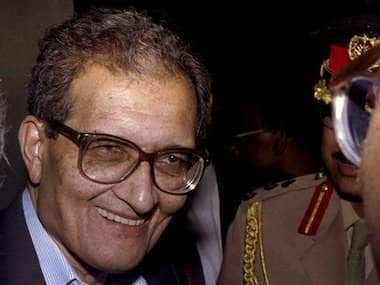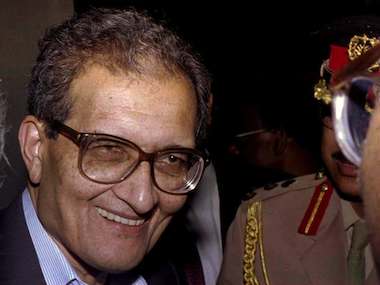IT is one of the easiest accusations to make - that we in the media are biased. Amartya Sen
detailed quite effectively
the nature of a pluralised media where the same story is framed through different headlines.Type in any subject into Google and you get a multitude of variations on the same “facts”, something particularly apparent with anything political, in any country. But Dr Sen also refers to “the choice of what news to cover and what to ignore”, in particular relating to class divisions in India. He says, “There tends to be fulsome coverage in the news media of the lifestyles of the fortunate, and little notice of the concerns of the less fortunate.” This is not unique to India actually. The Globe and Mail in Canada,
which recently focused on Dalit girls in India
, is obsessed [caption id=“attachment_177465” align=“alignright” width=“380” caption=“Amartya Sen was prescient in an editorial in The Hindu for a fast commercialising, hyper-competitive Indian media.”]
 [/caption] with political machinations and wealth at home. Sometimes this is a matter of audience. The Financial Times in London offers a regular weekend magazine supplement, “How to Spend it”, featuring the most lavish of items one could possibly buy. The FT is read by those in power and in wealth, so that suits. And there are serious and costly examples of when the media goes wrong. A tabloid reporter in Vancouver, Canada, once told me her editors “didn’t think there was a story” in the dozens of women who went missing from the city’s downtown eastside. That the women were prostitutes meant they had less value than ‘regular’ human beings, and the story did not get the coverage it deserved for years. The name of the serial killer who was eventually convicted of six murders and connected to more than 20 others, was known in the mid 1990s, but nothing was done by the media or police. By comparison, the murders of five women in Ipswich, England, in 2006, garnered immediate and considerable attention. One campaigner in Vancouver had said their murders got that sort of coverage, perhaps the killings would have been stopped at five, instead of leading to dozens more. I have always rejected what is taught as the first precept of Canadian journalism programmes: objectivity. Here’s some examples why it doesn’t exist: - in reference to a picture of a teenager with Down’s Syndrome who won a local contest, “We don’t run pictures of people like that”. - in reference to a photo required in a classroom of young pupils, “Make sure there’s no fatties, uglies or ethnics”. - in reference to warnings by the police of threats to children being taken out of the UK and being subjected to female genital mutilation, “It doesn’t pass the corn flakes test” (ie people don’t want to read that sort of thing over their breakfast) - in reference to the issue of rape of men in Scotland, “[It’s] too icky”. Getting some stories in print depends on the time of day, the mood of the news editor, the mood of his or her boss, and of course, what else is happening in the world. Think of all the stories that never saw the light of day once Michael Jackson died? In the UK, most papers scrapped the front half of their pages for news and tributes to such a massive event. It is difficult to explain “news sense” sometimes to non-reporters. There is an almost guttural sense of, “Yes, that’s a story” when you hear a certain quote or fact. Dr Sen is right to point out that those quotes must be accurate in the first instance, and it is right to require shorthand from reporters and increasingly audio recordings of quotes as backup. Quotes can look quite different in print when we see them - “I’m sure I didn’t say THAT” - as the imperfect representation of what was in our heads, and when framed within a complete story, headlined and tweeted across the internet. Reporters frequently clean up grammar and change the order of the quotes to meet the flow of a story, giving structure to expressed thoughts which frequently lack structure. It is an ongoing debate how much correction is fair, but quotes overall must be an accurate representation of what was said, not an interpretation. Sometimes “distortion” comes from the simple matter of not being able to reach someone for a quote. If the person you need to balance a story doesn’t answer their phone, or doesn’t return a request for comment, you get a lopsided piece. It’s easy for the public to say, “You should have waited”, but that same public demands their news at an ever faster pace, accelerated by the internet. In an ideal world, mainstream media outlets should question corruption in any sphere, any use and management of public funds, the fair and effective functioning of the courts, public and political apathy, and human suffering on any level. As I was taught, “News is what is new”. That’s my ideal as an individual reporter. But I exist within a media world with agendas and more significantly the need for money. The drive to earn cash to survive as a business means we supply what the public is perceived to want, frequently celebrity fluff. If the British public wanted more “public interest journalism”, then the Guardian newspaper would have seen a substantial jump in sales after the phone hacking scandal last year. It didn’t. The tabloids continue to sell millions more copies. For individual businesses, that forces a choice of what content to create. Dr Sen may be critical of the media as a whole, but as India gains more newspapers and more news websites, the diversity will potentially offer more unique content, and more content on the economic and societal disparities he rightly highlights. The danger will be that increased competition means increased demand for faster news, and that’s when accuracy falls down. On that call, we in the profession should all heed Dr Sen’s call.
[/caption] with political machinations and wealth at home. Sometimes this is a matter of audience. The Financial Times in London offers a regular weekend magazine supplement, “How to Spend it”, featuring the most lavish of items one could possibly buy. The FT is read by those in power and in wealth, so that suits. And there are serious and costly examples of when the media goes wrong. A tabloid reporter in Vancouver, Canada, once told me her editors “didn’t think there was a story” in the dozens of women who went missing from the city’s downtown eastside. That the women were prostitutes meant they had less value than ‘regular’ human beings, and the story did not get the coverage it deserved for years. The name of the serial killer who was eventually convicted of six murders and connected to more than 20 others, was known in the mid 1990s, but nothing was done by the media or police. By comparison, the murders of five women in Ipswich, England, in 2006, garnered immediate and considerable attention. One campaigner in Vancouver had said their murders got that sort of coverage, perhaps the killings would have been stopped at five, instead of leading to dozens more. I have always rejected what is taught as the first precept of Canadian journalism programmes: objectivity. Here’s some examples why it doesn’t exist: - in reference to a picture of a teenager with Down’s Syndrome who won a local contest, “We don’t run pictures of people like that”. - in reference to a photo required in a classroom of young pupils, “Make sure there’s no fatties, uglies or ethnics”. - in reference to warnings by the police of threats to children being taken out of the UK and being subjected to female genital mutilation, “It doesn’t pass the corn flakes test” (ie people don’t want to read that sort of thing over their breakfast) - in reference to the issue of rape of men in Scotland, “[It’s] too icky”. Getting some stories in print depends on the time of day, the mood of the news editor, the mood of his or her boss, and of course, what else is happening in the world. Think of all the stories that never saw the light of day once Michael Jackson died? In the UK, most papers scrapped the front half of their pages for news and tributes to such a massive event. It is difficult to explain “news sense” sometimes to non-reporters. There is an almost guttural sense of, “Yes, that’s a story” when you hear a certain quote or fact. Dr Sen is right to point out that those quotes must be accurate in the first instance, and it is right to require shorthand from reporters and increasingly audio recordings of quotes as backup. Quotes can look quite different in print when we see them - “I’m sure I didn’t say THAT” - as the imperfect representation of what was in our heads, and when framed within a complete story, headlined and tweeted across the internet. Reporters frequently clean up grammar and change the order of the quotes to meet the flow of a story, giving structure to expressed thoughts which frequently lack structure. It is an ongoing debate how much correction is fair, but quotes overall must be an accurate representation of what was said, not an interpretation. Sometimes “distortion” comes from the simple matter of not being able to reach someone for a quote. If the person you need to balance a story doesn’t answer their phone, or doesn’t return a request for comment, you get a lopsided piece. It’s easy for the public to say, “You should have waited”, but that same public demands their news at an ever faster pace, accelerated by the internet. In an ideal world, mainstream media outlets should question corruption in any sphere, any use and management of public funds, the fair and effective functioning of the courts, public and political apathy, and human suffering on any level. As I was taught, “News is what is new”. That’s my ideal as an individual reporter. But I exist within a media world with agendas and more significantly the need for money. The drive to earn cash to survive as a business means we supply what the public is perceived to want, frequently celebrity fluff. If the British public wanted more “public interest journalism”, then the Guardian newspaper would have seen a substantial jump in sales after the phone hacking scandal last year. It didn’t. The tabloids continue to sell millions more copies. For individual businesses, that forces a choice of what content to create. Dr Sen may be critical of the media as a whole, but as India gains more newspapers and more news websites, the diversity will potentially offer more unique content, and more content on the economic and societal disparities he rightly highlights. The danger will be that increased competition means increased demand for faster news, and that’s when accuracy falls down. On that call, we in the profession should all heed Dr Sen’s call.
Tristan Stewart-Robertson is a journalist based in Glasgow, Scotland. He writes for Firstpost on the media, internet and serves as an objective, moral compass from the outside.
)